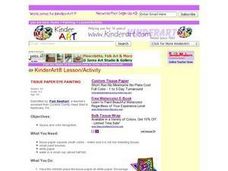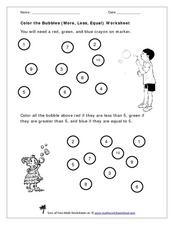Curated OER
Sensational Colors
In this writing worksheet, students prepare to write a poem about a color they have chosen. First students think about descriptive words pertaining to their color and the 5 senses. The students then write the poem and evaluate it using a...
Curated OER
Ordinals
Use beaded necklaces to practice with ordinal numbers and sequencing. For the first, scholars color the beads blue, red, or yellow based on their given positions (1st, 3rd, etc.). The next set of beads has learners do the opposite,...
Curated OER
Colors Quiz
Instead of using this resource as a quiz, consider dividing each of the six activities into small, daily bell-ringers. Some of the activities recall vocabulary words; the first exercise has learners unscramble Spanish colors to complete...
Curated OER
Tissue Paper Dye Painting
Use tissue paper squares to create collage art. Young artists discuss colors as they place and glue each piece of tissue on the paper. Tip: Cut out large basic shapes instead. Have the class create images using the tissue...
Curated OER
Watercolor Rainbows
Who doesn't love a rainbow? Little ones adore them, so why not make rainbows the subject of your next art project. Your class can use watercolor to paint rainbows. As they do, have them identify the colors in the rainbow, talk about how...
Curated OER
Mixing Colors with Corn Syrup and Food Coloring
Anyone who has worked with small children know that color identification and color mixing can be fun! This simple idea has a lot of potential. It suggests to mix food coloring with corn syrup to provide an opportunity for color mixing...
Curated OER
Write the Word
Combine several concepts with youngsters, who will enjoy expressing their artistic side as they identify shapes and practice printing. First, scholars trace the word yellow and use this color to shade all the rectangles they...
Curated OER
Animal Masks
Learners create wonderfully animate animal masks out of balloons. They use the papier-mache technique to create three dimensional animal masks taking care to consider color, shape, texture, and the animals' features.
Curated OER
Butterflies and Addition Sentences Worksheet
These butterflies need some color! Learners solve each of the nine single-digit addition problems to discover what color each butterfly will be according to the color key. The sums are between 1 and 10, and not all numbers will be used....
Curated OER
Paul Gauguin: Complimentary Color
First introduce your art class to the master, Paul Gauguin, then to the concept of complimentary colors. This slideshow provides a bit of background on the famous artist then walks kids through a step-by-step process intended as a study...
Curated OER
Two Layer Painting
With a little extra tag board and some tempera paint, learners can explore warm and cool colors. They create a two layered drip painting where they focus on mixing both cool and warm colors to achieve a fascinating effect.
Curated OER
Tissue Paper Butterfly
Creating butterfly art is as simple as 1-2-3. Kids cut coffee filters into butterfly shapes. Next, they wet and place squares of tissue paper onto the filters. Fifteen minutes later, they lift the tissue to reveal a colorful pattern...
Curated OER
Crepe or Tissue Paper Blots
What happens when you drip vinegar onto tissue paper? The colors bleed, leaving an interesting and organic design. Get your class observing and creating with this quick-and-easy art project. Tip: This can also be done using coffee...
Curated OER
Cornmeal with Powder Paint
Pre schoolers use art to build observational skills and eye-hand coordination. They squeeze art into a ribbon like shape on their paper, then sprinkle cornmeal and powder paint over it. They watch as water is sprayed on top of the...
Curated OER
Flower Painting/Printmaking
Using old or donated flowers, little learners create flower prints. They discuss the colors found in nature, paint a background, and then create flowers for their pictures by dipping and pressing real flowers onto their paper.
Curated OER
Understanding Visual Fractions
Using fractions as their artistic guide, learners color in parts of five shape images. Each image is segmented based on the denominator, so scholars simply need to apply the numerator to know how much to color. None of these are mixed...
Curated OER
Color the Bubbles (More, Less, Equal)
Combine coloring and number comparisons with your youngsters. They use color coding to identify numbers that are less than, greater than, or equal to five. The 20 numbers are enclosed in bubbles, making this more of a fun...
Curated OER
The Color Wheel
Hand out this nifty resource to make your next lesson on the color wheel a snap. It is a picture of the color wheel alongside a description of primary, secondary, and mixing colors. Great for artists of any age.
Curated OER
Benham's Disk
Seeing is believing! Or is it? With this simple experiment, young scientists can explore the concept of visual perception. Attach Benham's disk to a rotating appliance such as a hand drill; As it spins, the black lines appear to be...
Curated OER
Crayon Etching (Scratch Art)
What to do at a time when we have a little extra time to fill and need an activity that won't take a lot of prep? This art project is simple and can be linked to various other subjects. Learners use crayons to color in their paper, then...
Curated OER
Counting Coloring Puzzle
If your kids enjoy color-by-number, they will be excited about this worksheet! Using a color key, they match numbers on a picture of a bee by coloring them the corresponding shade. There is a trick here: although the number 10 is listed...
Curated OER
Circle, Count, and Color Shapes
Get your geometers familiar with shapes as they circle, color, shade, and count sets of rectangles, triangles, circles, squares, and trapezoids. For each of the 10 sets, they examine six figures and follow instructions to mark the...
Curated OER
Now You See Me, Now You Don't
Bioluminescence fascinates most upper elementary scientists. Display images of different glowing deep-sea organisms and discuss their environment. Young biologists then experiment with images and different colors of filtered light. In...
Curated OER
Color Theory
Sixth graders explore the basics of color mixing with paint by creating secondary and tertiary colors. Individually, 6th graders create their own paintings based on a popular series of sculptures.

























